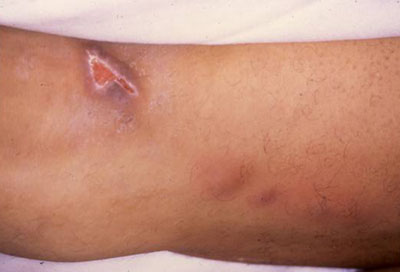History and exam
Key diagnostic factors
common
fever
lymphadenopathy
Ulceroglandular and glandular tularemia present with unilateral and localized tender lymphadenopathy. Pharyngeal and oculoglandular tularemia may also be accompanied by regional lymphadenopathy.[1] [Figure caption and citation for the preceding image starts]: Ulceroglandular tularemia of the lower extremity from a tick bite; ulcer over the patella and ascending lymphadenopathy are evidentCourtesy of Barry Farr, MD, MPH [Citation ends].
painful skin ulcer
unilateral conjunctivitis
Seen with oculoglandular tularemia.[1]
Other diagnostic factors
common
headache
All forms of tularemia are accompanied by systemic symptoms such as headache. Acute headache may rarely be a symptom of tularemic meningitis or brain abscess.[1]
malaise/fatigue
All forms of tularemia are accompanied by systemic symptoms such as malaise and fatigue.[1]
myalgia
All forms of tularemia are accompanied by systemic symptoms such as myalgia.[1]
anorexia
All forms of tularemia are accompanied by systemic symptoms such as anorexia.[1]
abdominal pain
All forms of tularemia are accompanied by systemic symptoms such as abdominal pain.[1]
vomiting
All forms of tularemia are accompanied by systemic symptoms such as vomiting.[1]
rales
Heard on auscultation with pneumonic tularemia.
nonproductive cough/dyspnea
Seen with pneumonic tularemia. Dyspnea occurs on exertion. Patients may also report chest tightness or pleuritic pain.[1]
sore throat
Seen with pharyngeal tularemia. Associated with exudative pharyngitis or tonsillitis.[1]
photophobia
Occurs in oculoglandular tularemia.[1]
uncommon
vision impairment/loss
Occurs in oculoglandular tularemia.[1]
jaundice, hepatosplenomegaly, diarrhea
Seen in typhoidal tularemia.
Jaundice is often accompanied by cholestasis.
positive Kernig/Brudzinski sign, stiff neck
Rare presentation seen in tularemic meningitis.
Risk factors
strong
tick exposure
biting fly exposure
Can be acquired from biting deer flies in, for example, California, Nevada, and Utah in the West of the US.[16]
contact with infected animals
yard work in areas where infected animals live
spring or summer season
More common in spring and summer, as it can be a tick-borne disease, and this is when tick exposure is at its peak.[1]
Use of this content is subject to our disclaimer